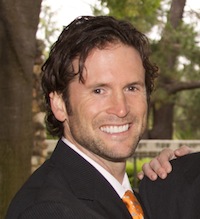

Aaron Ross – Predictable Revenue Drives Growth
 Aaron Ross is the author of the award-winning bestseller Predictable Revenue: Turn your Business into a Sales Machine with the $100 Million Best Practices of Salesforce.com.
Aaron Ross is the author of the award-winning bestseller Predictable Revenue: Turn your Business into a Sales Machine with the $100 Million Best Practices of Salesforce.com.
He is also the CEO and Founder of Predictable Revenue, which teaches companies how to grow sales faster and more predictably. Previously, Ross helped create a revolutionary Cold Calling 2.0 inside sales process and team at Salesforce.com that helped the company increase its revenues by $100 million. He has been featured in Time and Businessweek and is also the author of CEOFlow: Turn Your Employees into Mini-CEOs and Sons Love Drawing Mutant Robot Battles with Dads. We recently had the pleasure of speaking with Aaron on a variety of topics, including what he learned during his time at Salesforce.com, how to grow sales teams appropriately and what has changed in sales management in the two years since Predictable Revenue was published.
Tell us about your key findings of what you learned at Salesforce and recommended in your book Predictable Revenue?
I learned people want “predictable revenue” because one unpredictable good quarter is not good enough – they want consistency year-over-year and they want the type of business growth that is not based on guessing and reactive, last-minute hustling at the end of each quarter or month. They want a process that is based on a formulaic and consistent approach – that is what is valuable.
They want to build a “sales machine,” a business that generates predictable revenue, and there are three keys: a) repeatable lead generation programs, b) consistent sales processes and c) customer success with your product.
One key idea about helping you avoid lead generation roller coasters is understanding how not all leads are created alike. The three main types of leads have different conversion rates and sales cycles:
-
Seeds – Word-of-mouth or referrals from previous happy customers, these are the most profitable leads but it is challenging to proactively grow them.
-
Nets – These are marketing leads, such as from internet marketing or a traditional one-to-many model of marketing.
-
Spears – This is a targeted approach driven by sales development reps (SDRs), aka your prospecting teams (the Cold Calling 2.0 approach).
If you understand the three types, there is really one best way to grow each type. The best way to grow Seeds is to have a dedicated customer success person and program. The best way to grow Nets is through inbound marketing. The best way to grow Spears is through cold calling 2.0 and a team of dedicated prospectors.
To build a “Sales Machine” and predictable revenue, should you quickly start growing your sales team?
Sales VPs and Board members make painful planning mistakes every year. They think that adding sales people and working them harder will grow revenue. They think that to double revenue, they need to double the sales force to drive it and work the current team harder, like making more dials per day. WRONG!
Working harder and making more calls does not scale. In the most effective sales organizations, salespeople don’t grow customer acquisition – they fulfill it. This is a major shift from traditional sales. If something is not working, then working harder just means that what the sales team was already doing isn’t working, yet they go ahead and do more of it. I see a future in which sales is more and more like account management, and customer acquisition is squarely in the hands of marketing.
Board members and CEOs exacerbate the problem. They tend to rush to set 100%+ growth targets and arbitrarily pick these goals since there is no data to base these predictions on, and then they turn the screws on the VP of sales who ultimately misses the plan, the company misses the target and the executive team is fired or changed. The new team tries to hire more people to hit the targets and this doesn’t work either. The Board and CEOs keep making the same dumb mistakes because people under pressure tend to retreat to what they know rather than taking the risk of trying new things – they end up doing more of what is not working than taking a step back and figuring out a new approach.
What’s your secret sauce and how is your approach different for building high growth companies with inbound and prospecting teams?
I spend a lot of energy creating a successful system to hire people into. Many companies have a bad sales system and a high failure rate. If you are churning more than 10% of your people or if more than 20% of your people are missing quota, then you have a bad system, not bad people.
I’m also a big believer in the need to specialize, specialize, specialize! You have to have everyone focus – see the chart below, for example. SDRs (i.e. prospectors) should JUST prospect and not to inbound leads. There should be a Marketing Response Rep (MRR) who specializes in qualifying marketing or inbound leads, rather than doing Cold Calling 2.0 like his SDR colleagues.
What are some of the best practices of generating leads through inside sales that you recommend companies implement immediately?
Identify your Ideal Customer Profile (ICP) first, angling it towards your top 20% of customers. Train your people and give them the support they need. Don’t forget that they should have specialized skills and job responsibilities.
What common things do you see companies doing wrong when building inside sales and prospecting engines?
Brute force lead generation – “give me more leads!” – when they don’t understand that not all leads are the same. Another big mistake is not having specialized focus. Sales people shouldn’t be prospecting.
Companies treat all leads the same. CEOs, Sales VPs, Marketing VPs – they sit at the board meeting and set hyper goals. This exacerbates the problem because the kinds of leads you can grow are Nets and Spears but these conversion rates are way lower than seeds.
What do you see as a trend for inside sales in 2013?
Companies have to figure out how to sell in a way that makes you happy and your clients happy. This requires impeccable honesty. It’s not just about building a product. Sell ideas, not stuff. People are overwhelmed – they need to build a great product but they also need to teach customers how to get value from it. They need to get buy-in on their ideas.
What is your definition of sales management and what do you view as the top objective of inside sales management especially with respect to managing inside sales?
Be a good coach. Don’t do things for people, but coach them to do it, even if it takes longer. If you want something bigger than you, learn to let go, let people fail. Don’t try to control it, own it or take credit for it.
Be a good entrepreneur. Your team is your business. Be a Mini CEO and teach your people to be Mini CEOs.
Has anything changed since you wrote Predictable Revenue that you would want to include now if you wrote the next edition?
I would add a chapter on “How to sell ideas and not stuff” – companies should be selling ideas more than benefits. For example, Hubspot sells the idea of Inbound Marketing. Salesforce sells the idea of the cloud.
Another change is that in the past, salespeople lied and manipulated to make a sale. Over the last 10 years, things have changed. With subscription models, you can’t make empty promises because people can cancel. To be successful, you need to figure out how to help your customers and be of value to them.
What key performance indicators and metrics do you use as a sales manager for inside sales? What KPIs do you use as a CEO of a company?
For a sales development manager, there are weekly and monthly activity metrics that we track for prospectors. Some main ones include the number of call connects with prospects (goal: 25+ per week), the conversion rates of appointments scheduled to Sales Qualified Leads / Qualified Opportunities (goal: 70-80%+), and the dollar value of pipeline and revenue generated from these leads (it’s all about revenue, not just leads). The main leading indicator of future revenue is the dollar value of qualified pipeline created per month, so we want CEOs watching that closely.
Also, we see lots of companies under-hiring in their inbound lead response reps role (a.k.a. Market Response Reps); each Market Response Rep should receive no more than 400 leads per month to deal with, or else things drop through the cracks fast.
For the prospecting team, you have to tie compensation to a few things. First, pay people enough of a base salary so they don’t worry about rent. Otherwise, they will do stupid things with your prospects. Then, their commission should be tied to 1) the number of qualified opportunities generated per month and 2) a percentage of revenue that came from the deals they sourced.
I like to set a bar of success for some basic metrics that are achievable to make people feel successful. Give people a path to success. You can’t have predictable revenue if you’re not tracking and measuring metrics correctly and regularly. If you can’t understand what works and what doesn’t, then you are not able to manage it and grow it.
Find out more about Aaron and Predictable Revenue at https://predictablerevenue.com/ or follow Aaron on LinkedIn or Twitter.

